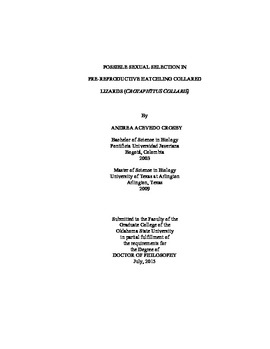| dc.contributor.advisor | Fox, Stanley F. | |
| dc.contributor.author | Crosby, Andrea Acevedo | |
| dc.date.accessioned | 2016-09-29T18:39:27Z | |
| dc.date.available | 2016-09-29T18:39:27Z | |
| dc.date.issued | 2015-07 | |
| dc.identifier.uri | https://hdl.handle.net/11244/45244 | |
| dc.description.abstract | We studied the possible adaptive significance of precocial sexual signaling in collared lizard hatchlings. Male hatchlings display intense dorsolateral orange bars at hatching or within the first weeks of life. Hatchling orange bars (HOB) increased in saturation with body size until reaching a threshold, and then faded as adult coloration began to show. In most organisms, sexual dichromatism (usually present only in adults) has been related to androgens and aggressive behavior. It is unknown how androgen levels are related to the expression of the orange bars in male hatchling collared lizards. We tested the hypothesis that male hatchlings with higher levels of androgens would show greater proportion of orange, higher orange saturation (color purity), and more aggressive behavior than those with lower levels of androgens. We first tested this hypothesis by manipulating androgen levels through implants of testosterone (T) and dihydrotestosterone (DHT). Both proportion of orange and orange saturation increased the most with DHT. When DHT was implanted, almost 40% of the variation in aggression was explained by DHT. We then examined relationships of unmanipulated levels of T and DHT with coloration and aggressive behavior in wild-ranging male hatchlings. Although not statistically significant, our results showed a positive trend between orange saturation and DHT. Hatchlings with higher saturated orange bars tended to behave more aggressively than those with less saturated bars. Finally, to determine if HOB are related to fitness in sexually mature males, we measured inferred fitness in yearlings and adults at the same population and related it to the proportion of orange and orange saturation that those yearlings and adults had when hatchlings. Our results suggested that hatchlings with more orange coloration had a higher probability of pair-bonding, displaced less from their natal locations, had larger home range areas (as adults, but not as yearlings), and had higher inferred fitness (as adults, but not as yearlings). Thus, it is suggested that precocial sexual signaling in hatchlings is positively related to estimated fitness in adults as estimated from spatial data, but not so in yearlings when yearling males, unlike adults, likely gain their fitness by sneaking copulations. | |
| dc.format | application/pdf | |
| dc.language | en_US | |
| dc.rights | Copyright is held by the author who has granted the Oklahoma State University Library the non-exclusive right to share this material in its institutional repository. Contact Digital Library Services at lib-dls@okstate.edu or 405-744-9161 for the permission policy on the use, reproduction or distribution of this material. | |
| dc.title | Possible sexual selection in pre-reproductive hatchling collared lizards (Crotaphytus collaris) | |
| dc.contributor.committeeMember | Lovern, Matthew B. | |
| dc.contributor.committeeMember | Grindstaff, Jennifer | |
| dc.contributor.committeeMember | Gregory, Mark | |
| osu.filename | Crosby_okstate_0664D_14179.pdf | |
| osu.accesstype | Open Access | |
| dc.type.genre | Dissertation | |
| dc.type.material | Text | |
| thesis.degree.discipline | Zoology | |
| thesis.degree.grantor | Oklahoma State University | |
